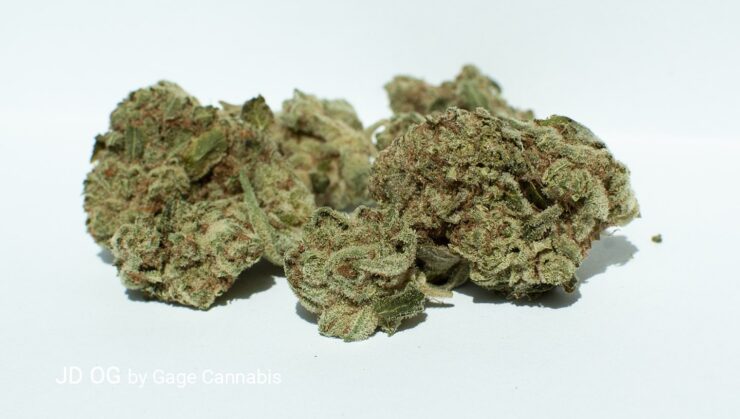When most people think of cannabis, THC immediately comes to mind. However, the cannabis plant is an intricate tapestry of compounds, with over 100 identified cannabinoids. Among these, a new entrant, THC-JD, has recently piqued curiosity.
In the ever-evolving world of cannabis, the rise of new cannabinoids is not uncommon. But, what’s unique about THC-JD is its sudden prevalence in commercial cannabinoid blends. In this post, we embark on a journey to unravel the mysteries of THC-JD.
The Cannabis Landscape: Over 100 Cannabinoids

Mother Nature is an expert chemist, and nowhere is this more evident than in the cannabis plant. With a rich profile of cannabinoids, terpenes, and flavonoids, cannabis presents a vast pharmacological treasure trove. Among the famous cannabinoids, delta 9 THC has dominated discussions and research due to its psychoactive properties. Yet, the diversity of the cannabis plant goes beyond just THC. As science delves deeper, it’s becoming clear that each cannabinoid, even the lesser-known ones, holds potential therapeutic benefits. However, less known cannabinoids like THC-H and THC-B are slowly emerging from the shadows, though much remains to be understood. Each of these compounds has its unique story, waiting to be told, and potential applications that could revolutionize medicine.
THC-JD: The Lesser-Known Cannabinoid
Despite its rising popularity, credible details about THC-JD are surprisingly scanty. The marketplace buzzes with anecdotal claims, yet these cannot replace the solid footing of scientific backing. This cannabinoid’s mystique has piqued the interest of many, from consumers to researchers. For consumers, the allure of this hemp lies in the reported effects, but without rigorous research, it’s like walking on a tightrope—enticing but treacherous. The world of cannabis is vast, and as outlets such as d8austin.com and their THC-JD offer gains traction, there’s an undeniable need for clarity. Hence, a call to the scientific community is warranted, urging them to bridge this knowledge gap and provide insights into its effects and safety.
Understanding Its Structure

At its heart, THC-JD, or Tetrahydrocannabioctyl, is a naturally occurring phytocannabinoid. As a variant of THC, it offers a unique spin with its octyl side chain. This structural nuance sets it apart from its cannabinoid cousins, hinting at a different interaction profile within the human body. While the octyl chain’s importance is not yet fully clear, preliminary understanding hints at its potential role in potency. This might position it as a contender in the potency race among cannabinoids. As researchers dive deeper into its molecular structure, the hope is to unravel the mysteries surrounding THC-JD and its potential therapeutic applications.
Does It Get You High?
Arguably one of the most asked questions, the psychoactive effects of THC-JD are still under the microscope. Anecdotal reports suggest a varied range of experiences. Some users claim to achieve a state of euphoria, while others report feelings of relaxation or sedation. As the cannabis industry continues to evolve, so does the curiosity surrounding new cannabinoids. The experiences shared by users have piqued interest, but without concrete scientific evidence, it’s challenging to draw definitive conclusions. It’s essential to approach it with an open mind, understanding that individual reactions may differ based on numerous factors.
Exploring the Effects of THC-JD

Anecdotal evidence has flooded forums with claims of THC-JD’s effects. Many users report feelings akin to a mellow high, with undertones of relaxation and sedation. However, these reports vary, with some users suggesting more vivid experiences. As the cannabis community grows, so does the chatter about THC-JD. While these personal accounts provide a glimpse into potential effects, they are not a substitute for scientific research. It’s crucial to approach these claims with a grain of skepticism, recognizing that everyone’s body reacts differently to cannabinoids.
Safety Concerns
Any new compound’s introduction, especially one consumed, rightly raises safety concerns. As with its effects, the safety profile of THC-JD is still under study. This underscores the importance of third-party testing to ensure transparency and build consumer trust. In an era where consumers are more conscious about what they ingest, the demand for clear information is paramount. Until more research is conducted, it’s essential to rely on trusted sources and verified products. Ensuring that its products adhere to safety standards is a collective responsibility between manufacturers and consumers.
THC-JD vs. Delta 9 THC

While they share some similarities, the distinction between THC-JD and delta 9 THC is marked by their structural differences. Interestingly, most commercially available THC-JD is semi-synthetic. The production methods employed often differ, lending a unique profile to the final product. This distinction is crucial for consumers who want to understand the nuances of the products they consume. The semi-synthetic nature of this hemp also raises questions about its purity and the processes involved in its creation. As the market for cannabinoids expands, understanding these differences becomes even more vital.
Drug Testing and THC-JD
Another hot-button topic is THC-JD’s appearance in drug tests. Given its structural nuances, there’s potential for THC-JD to register in screenings. Users must be cautious, understanding the implications of metabolization and potential test outcomes. The world of employment and competitive sports often requires drug testing, and a positive result can have significant repercussions. It’s essential for users to be informed and aware of how THC-JD might interact with these tests. Until more is known, it’s best to err on the side of caution and consider potential risks.
Legal Status of THC-JD

Protected under the 2018 Farm Bill, THC-JD has a unique legal standing. However, state-specific regulations can blur these lines, especially when distinguishing between hemp and marijuana products. Consumers must be vigilant and stay informed of evolving legal landscapes. As cannabis laws continue to change across the U.S., understanding the nuances of each state’s regulations becomes paramount. It’s not just about federal laws but also about local ordinances that might affect the sale, possession, and consumption of THC-JD products.
Purchasing THC-JD: What to Look For
Safety first! Always prioritize third-party testing results when considering a THC-JD purchase. This not only ensures product safety but also guarantees informed choices. In a market flooded with various cannabis products, discerning genuine from counterfeit becomes crucial. Verified third-party testing can provide insights into the product’s purity, potency, and overall quality. Consumers should also consider the reputation of the brand, reviews from other users, and the transparency of the company in sharing information about their products.
Conclusion: The Future of THC-JD Research
The world of THC-JD remains largely uncharted, but its potential is undeniable. As the cannabis industry evolves, the need for comprehensive THC-JD research becomes paramount. Who knows? This lesser-known cannabinoid might just be the next big thing in the cannabis cosmos.

